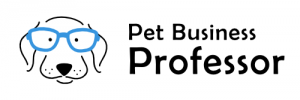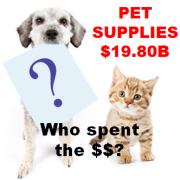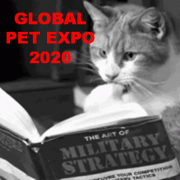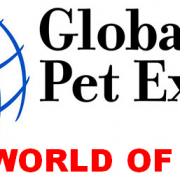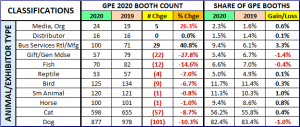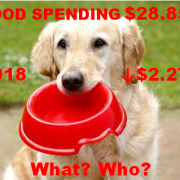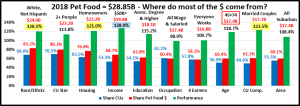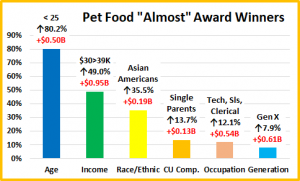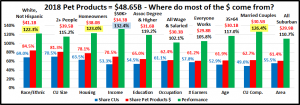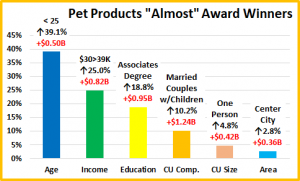2018 Pet Supplies Spending was $19.8B – Where did it come from…?
Next, we’ll turn our attention to Pets and Supplies. We’ll see some differences from Pet Food as the spending in the Supplies segment is more discretionary in nature. There are other factors too. Many supplies categories have become commoditized so pricing changes (CPI) can strongly impact Consumers’ buying behavior in this segment. Supplies’ Spending can also be affected by the spending behavior in other segments, especially Food. Consumers often trade $ between segments. In the second half of 2016, Supplies began a 24 month spending lift. The increase totaled $4.97B and ended in the second half of 2018 with a slight drop, -$0.01B. Coincidentally, the drop correlated with new added tariffs on Supplies. The net 2018 result for Supplies was a $1.22B (6.6%) spending increase.
Let’s see which groups were most responsible for the bulk of Pet Supplies spending in 2018 and the $1.22B lift. The first chart details the biggest pet supplies spenders for each of 10 demographic categories. It shows their share of CU’s, share of Supplies spending and their spending performance (Share of spending/share of CU’s). Although their share of the Pet Supplies $ may be different, all of the big spending groups are the same as Total Pet. Remember, for Food the age group is slightly older. The categories are presented in the order that reflects their share of Total Pet Spending. This highlights the differences in importance. All 10 of the groups have over a 60% market share. Pet Food had 9. We’re also back to 6 groups with performance over 120%. Pet Food had only 4. Education and Age dropped out. Higher Education correlates with higher income and income is more important in Supplies spending. Supplies spending also skews younger
- Race/Ethnic – White, not Hispanic (86.3%) up from (84.2%) This large group accounts for the vast majority of spending in every segment. Their performance rating was up from 122.9% to 125.0%. They are #4, but in a virtual 3 way tie for 3rd in terms of importance in Supplies Spending. Minority groups account for 31% of all CUs but spend only 13.7% of Supplies $. This is primarily due to lower income for Hispanics and African Americans and a lower rate of pet ownership in African American and Asian American CUs.
- # in CU – 2+ people (82.7%) down from (82.8%) Their Supplies performance was 117.3%, up from 116.1%. They lost share but increased performance because of a big increase in the number of single CUs, but singles perform so poorly. 2 People CUs dominate share. However, the performance in 2+ CUs is 100+% for all sizes. In Supplies spending, it definitely “just takes two.”
- Housing – Homeowners (79.9%) up from (79.4%) Homeownership is a major factor in pet ownership and spending in all industry segments. Their performance was down slightly to 125.9%, from 126.2%, but they held on to 3rd place in terms of importance for increased Pet Supplies spending. All groups, Homeowners and Renters spent more. However, the bulk of the spending lift – $0.8B (65%) came from Homeowners with a mortgage.
- Income Over $50K (73.3%) up from (71.3%) With a performance rating of 137.6%, down from 138.8%, CU income is the single most important factor in increased Pet Supplies Spending. The increased discretionary nature of much of Supplies spending pushes the share and performance level higher than that of Pet Food. However, it is still significantly below the Service Segments. Higher Income still generally generates Higher Pet Supply Spending.
- Education – Associates Degree or Higher (68.2%) up from (65.6%) Higher Education gained market share and their performance level rose from 122.2% to 125.0%. They stayed 4th in importance for generating greater Supplies spending. Higher Education generally produces higher income.
- Occupation – All Wage & Salary Earners (65.2%) up from (63.4%) – The performance of this group was 106.8%, up from 103.8%. In a marked contrast to Pet Food, they gained in share and performance as all wage/salary groups spent more on Supplies. However, half of the group’s spending comes from the higher income Mgrs/Professionals.
- # Earners – “Everyone Works” (65.4%) up from (62.5%) In this group, all adults in the CU are employed. Income is important in Supplies Spending and the only thing holding this group back is the poor performance by 1 earner, singles. CUs with 2+ Earners spent $1.22B more on Supplies. The group performance went from 109.1% to 113.2%.
- Age – 35>64 (65.2%) up from (64.1%) Traditionally, Supplies Spending skews more towards the younger groups. The 35>64 group maintained their dominance and even gained a little ground. Supplies Spending was up in all age segments of this group, but it was primarily driven by the 35>44-yr olds. The 65>74 yr olds spent less which contributed to the 35>64 performance level increasing to 123.2% from 120.0%. However, they stayed in 6th place.
- CU Composition – Married Couples (64.8%) up from (64.2%) Married couples are a big share of $ and perform well whether alone or with children. They gained slightly in share, as all segments spent more, especially Couples Only. Their performance also grew slightly from 129.7% to 130.5% and they remain 2nd in importance.
- Area – Suburban (63.3%) up from (63.0%) Suburban CUs are the biggest spenders in every segment. They gained a little ground in Supplies and their performance improved to 114.4%, from 113.3% in 2017. All areas spent more but the Suburbs over 2500 population had the biggest lift.
The biggest spending groups for Pet Supplies are the same as Total Pet and 9 of 10 are the same as Food. However, the discretionary nature of Supplies causes spending to be more impacted by income than Food. Groups associated with higher income, like Education and # Earners, perform better than in Food. Homeownership and Marriage had the most growth in Supplies $. Having 6 groups with 120+% performance also indicates greater disparity between segments.
Now, we’ll look at 2018’s best and worst performing Pet Supplies spending segments in each category.
Almost all of the best and worst performers are those that we would expect. In Pet Supplies spending, there are only 3 that are different from 2017. That is by far the least change of any segment, 4 fewer than Pet Food and 2 less than for Total Pet. As we move deeper into the data, we will start to see even more differences between the Industry Segments. Changes from 2017 are “boxed”. We should note:
- Income matters in Supplies spending.
- The 228.5% Performance by the $200K> group is 44.1% better than the best income segment in Food.
- 9 of the 12 winners for best performance had the highest income of any segment in the category. The other three came in 2nd – White, not Hispanics, Suburbs <2500 and the West.
- In Categories associated with Income, including # Earners, Occupation and Higher Education, the disparity between the best and worst performers grew in 2018. This indicates less balance in spending.
- Occupation – Blue-Collar workers lost last year. This year it was Retirees. After a huge lift in all segments in 2017, they cut back spending on everything but food in 2018. They still spent $0.5B more in 2018 on supplies than in 2016.
- # in CU –In 2018 the performance of 2 to 4 people CUs was again very close. 4 edged out 3 for the win. However, even 5+ earned their share at 100.6%. That truly leaves Singles “standing alone”. It just takes 2.
It’s time to “Show you the money”. Here are segments with the biggest $ changes in Pet Supplies Spending.
In 2018 Supplies Spending was up $1.22B. However, the ongoing lift, which began in the second half of 2016 ended in the second half of 2018 as spending flattened and then turned down slightly. In the chart, there are 6 repeats from 2017 – 5 winners and 1 loser. 5 segments switched from last to first or vice versa. However, this is much less turmoil than in the Food Segment. Tech/Sls/Clerical, 4 People CU’s and Millennials were surprise winners. However, the biggest surprise or change from 2017 was that in 3 of 12 Demographic Categories every segment increased spending on Supplies. In 2017 it was 10. This provides perhaps the first indication of the impact of the spending downturn in the second half of 2018. Here are the specifics:
- Race/Ethnic – The White, Non-Hispanics share of Supplies spending is 86.3%, but they produced 117%% of the lift.
- Winner – White, Not Hispanic – Supplies: $17.08B; Up $1.43B (+9.1%)
- 2017: White, Not Hispanic
- Loser – Asian Americans – Supplies: $0.41B; Down $0.19B (-31.3%)
- 2017: African Americans
- Comment – African Americans spent 11.8% more in 2018 but Hispanics spent 6.7% less. In 2017 all groups increased Supplies Spending. In 2018 the White, Not Hispanic group increased their dominance in Supplies.
- Winner – White, Not Hispanic – Supplies: $17.08B; Up $1.43B (+9.1%)
- Generation – The Boomers flipped from 1st to last but everyone else spent more.
- Winner – Millennials – Supplies: $4.57B; Up $0.90 (+24.7%)
- 2017: Baby Boomers
- Loser – Baby Boomers – Supplies: $6.86B; Down $0.62 (-8.3%)
- 2017: Silent Generation
- Comment – Just as they did in the Food Segment, the Millennials stepped up with the biggest increase, but once again, the Gen Xers weren’t far behind, +$0.85B
- Winner – Millennials – Supplies: $4.57B; Up $0.90 (+24.7%)
- Housing – All segments maintained their positions and all increased spending.
- Winner – Homeowner w/Mtge – Supplies: $10.80B; Up $0.80B (+8.0%)
- 2017: Homeowner w/Mtge
- Loser – Renter – Supplies: $3.98B; Up $0.15B (+3.8%)
- 2017: Renter
- Comment – Renters finished last but this year that meant a 3.8% increase. Unfortunately, Renters continue to lose ground to Homeowners. One factor is that the number of CUs is falling as Homeownership slowly increases.
- Winner – Homeowner w/Mtge – Supplies: $10.80B; Up $0.80B (+8.0%)
- # Earners – 1 Earner, 2+ CUs flipped for the second consecutive year and are back on the bottom.
- Winner – 2 Earners – Pet Supplies Spending: $8.26B; Up $0.80B (+10.6%)
- 2017: 1 Earner, 2+ CU
- Loser – 1 Earner, 2+ CU – Pet Supplies Spending: $4.13B; Down $0.17B (-4.1%)
- 2017: No Earner, Single
- Comment – Income is always a big factor and the # of Earners became more important in 2018, at least for the 70.5% of CUs with 2 or more people. Singles spent more on Supplies regardless if they worked or not. However, in 2+ people CUs, unless there were 2 or more earners, Supplies spending decreased. The 2 Earner CUs beat out the 3+ Earner CUs for the biggest increase for 1 simple reason. There are 4 times more of them.
- Winner – 2 Earners – Pet Supplies Spending: $8.26B; Up $0.80B (+10.6%)
- Occupation – The Tech/Sales/Clerical flipped to 1st from last.
- Winner – Tech/Sls/Clerical – Pet Supplies Spending: $3.26B; Up $0.77B (+31.0%)
- 2017: Mgrs & Professionals
- Loser – Retired – Pet Supplies Spending: $3.05B; Down $0.42B (-12.0%)
- 2017: Tech/Sls/Clerical
- Comment – Last year all groups spent more on Supplies. In 2018 all groups but Retirees spent more, even Blue-Collar workers. However, 63% of the increase was driven by Tech/Sls/Clerical workers. Their “Bosses”- Managers & Professionals and the Self-Employed supplied 32%.
- Winner – Tech/Sls/Clerical – Pet Supplies Spending: $3.26B; Up $0.77B (+31.0%)
- Education – BA/BS Degrees led the way for the second consecutive year.
- Winner – BA/BS Degree – Pet Supplies Spending: $6.27B; Up $0.76B (+13.8%)
- 2017: BA/BS Degree
- Loser – < High School Grads – Pet Supplies Spending: $0.60B; Down $0.17B (-22.4%)
- 2017: High School Grads
- Comment – There was another clear dividing line. All High School Grads with some college courses, specific job training or a formal degree spent more. Those with only a High School diploma or less, spent less.
- Winner – BA/BS Degree – Pet Supplies Spending: $6.27B; Up $0.76B (+13.8%)
- Area Type – Suburbs Over 2500 population kept the top spot.
- Winner – Suburbs >2500 – Pet Supplies Spending: $8.89B; Up $0.70B (+8.6%)
- 2017: Suburbs > 2500
- Loser – Suburbs < 2500 – Pet Supplies Spending: $3.64B; Up $0.12B (+3.5%)
- 2017: Rural
- Comment – All areas spent more but those with a population over 2500 supplied 80% of the increase.
- Winner – Suburbs >2500 – Pet Supplies Spending: $8.89B; Up $0.70B (+8.6%)
- Region – In 2017 All groups spent more. In 2018 all but the Northeast spent more.
- Winner – Midwest – Pet Supplies Spending: $4.27B; Up $0.67B (+18.6%)
- 2017: Northeast
- Loser – Northeast – Pet Supplies Spending: $3.35B; Down $0.40B (-10.7%)
- 2017: Midwest
- Comment – A dual flip. The Midwest flipped from last to first, but they now have 2 consecutive years of increases. They narrowly edged out the South for the win. The “score” was +$0.67B to +$0.64B.
- Winner – Midwest – Pet Supplies Spending: $4.27B; Up $0.67B (+18.6%)
- Income – Last year all groups spent more. This year it was truly a mixed bag with a new winner and loser.
- Winner – $200K > – Pet Supplies Spending: $2.95B; Up $0.61B (+26.2%)
- 2017: $150 to $199K
- Loser – $70 > 99K – Pet Supplies Spending: $2.88B; Down $0.16B (-5.2%)
- 2017: <$30K
- Comment – The Mixed Bag: <$40K and $70>99K groups spent less. $40>69K and Over $100K groups spent more.
- Winner – $200K > – Pet Supplies Spending: $2.95B; Up $0.61B (+26.2%)
- Age – Last year all groups spent more. This year the 65>74 yr olds were the only group to spend less.
- Winner – 35>44 yrs – Pet Supplies Spending: $4.05B; Up $0.56B (+16.0%)
- 2017: 55>64 yrs
- Loser – 65>74 yrs – Pet Supplies Spending: $2.36B; Down $0.09B (-3.8%)
- 2017: <25 yrs
- Comment: There were no repeats or flips and a very simple result with only 65>74 year olds spending less. The 35>44 year olds led the way but they had some help. In fact, the 25>54 year old range spent $1.13B more and accounted for 93% of the increase.
- Winner – 35>44 yrs – Pet Supplies Spending: $4.05B; Up $0.56B (+16.0%)
- CU Composition – Married Couples Only had a bad year in Food but again had the biggest increase in supplies $.
- Winner – Married, Couple Only – Supplies: $6.05B; Up $0.47B (+8.5%)
- 2017: Married, Couple Only
- Loser – Single Parents – Supplies: $0.63B; Down $0.19B (-23.4%)
- 2017: Unmarried, 2+ Adults
- Comment – The increases were small but widespread. All CUs but Single Parents and Married Couples with no children, but at least one other adult living with them spent more.
- Winner – Married, Couple Only – Supplies: $6.05B; Up $0.47B (+8.5%)
- # in CU – For the second consecutive year, all groups registered an increase.
- Winner – 4 People – Pet Supplies Spending: $3.11B; Up $0.34B (+12.3%)
- 2017: 2 People
- Loser – 5+ People – Pet Supplies Spending: $1.92B; Up $0.16B (+9.2%)
- 2017: 3 People
- Comment: The increases were very balanced across all sizes. 4 person CUs were up $0.34B. 5+ person CUs were up $0.16B. The smaller CUs, 1-3 people were all up from $0.22 to $0.28B.
- Winner – 4 People – Pet Supplies Spending: $3.11B; Up $0.34B (+12.3%)
We’ve now seen the winners and losers in terms of increase/decrease in Pet Supplies Spending $ for 12 Demographic Categories. In 2018, 24 months of strong growth slowed. 3 of 12 categories had no segments that spent less on Supplies but that was down from 10 in 2017. We saw many of the traditionally strong performers on the top again. There were 3 somewhat surprising winners, 4 Person CU’s, Tech/Sls/Clerical and Millennials, which all skew younger in age. However, not every good performer can be “the” winner and some of these “hidden” segments should be recognized for their outstanding performance. They don’t win an award, but they deserve…
HONORABLE MENTION
The numbers from these segments certainly merit their recognition for Honorable Mention. They also reinforce the gains in importance of Education, Income, Youth and Population density to increased Supplies spending. Adv. Degrees were the best performers and BA/BS had the biggest increase, but Assoc. Degree spent 20% more on Supplies. $100>149K finished 2nd but reinforces the importance of Income. Over $100K: +$1.31B. Under $100K: -$0.09B. The 25>34 yr olds had the second biggest increase, but the 25>44 yr olds provided 70% of the total lift. The South was within 5% of the winning Midwest region. Having “kids” was important as 3 people CUs was second only to 4 people CUs. Population mattered as Center City was second to Suburbs >2500. 2018 was not as great as 2017 but it was still pretty good as 72 of 92 Demographic Segments 78.3% spent more on Supplies.
Summary
While Pet Food spending has shown a definite pattern, Pet Supplies have been on a roller coaster ride since 2009. Many Supplies categories have become commoditized and react strongly to changes in the CPI. Prices go up and spending goes down…and vice versa. Supplies spending has also been reactive to big spending changes in Food. Consumers spend more to upgrade their Food, so they spend less on Supplies – trading dollars. We saw this in 2015. Then in 2016 the situation reversed. Consumers value shopped for Food, so they spent some of the “saved” money to increase their spending on Supplies.
That brought us to 2017. Both Supplies and Food prices deflated while the inflation rate in both of the Services segments dropped to lows not seen in recent years. Value was the “word” and it was available across the market. Perhaps the biggest impact was that the upgrade to super premium Food significantly penetrated the market. This could have negatively impacted Supplies Spending, but it didn’t. Supplies’ spending increased in 93% of 92 demographic segments.
2018 started out as expected with a $1B increase in Supplies and a small lift in Food. Then the government got involved. In July the FDA issued a warning on grain free dog food and spending dropped over $2B. New tariffs were implemented on Supplies and spending flattened out then turned down $0.01B in the 2nd half. Because of shipping timing, the retail impact of Tariffs is delayed. However, in the 2nd half of 2018 they seem to have started to affect Supplies spending.
Among the demographic categories in which a consumer has some control, Higher Income, Marriage, Homeownership and Higher Education are still the biggest factors in increased Supplies spending. In 2018 Income stayed on top but some categories directly associated with income, Occupation, # of Earners and Higher Education also increased in importance.
Increased Tariffs mean increased prices which negatively impacts Supplies Spending. Let’s take a demographic look. The 12 best performing segments were all 1st or 2nd in income. The 12 worst performers were all at or near the bottom in income. 8 of the 12 groups with the biggest increase were also in the top 2 in income. Half of the losers were in the income basement. There were 20 segments with decreased Supplies Spending. Half had very low income.
It appears that 2018 increased the overall importance and reach of income in Supplies Spending. The one exception was the Millennial Movement. They rank only 3rd in income but the older ones are at or above the national average.
It will be interesting to see how the tariffs affect 2019 Supplies Spending.
Finally – The “Ultimate” Pet Supplies Spending CU consists of 4 people – a married couple, with 2 children, the oldest is over 18. They are in the 45 to 54 age range. They are White, but not of Hispanic origin. At least one of them has an advanced College Degree. Both of them work, running their own business and their oldest child just started a part time, after school job. They’re doing well with an income over $200K. They live in a small suburb, adjacent to a big city in the Western U.S. and are still paying off the mortgage.
